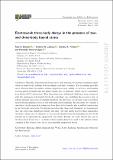Electroweak three-body decays in the presence of two- and three-body bound states
Author(s)
Briceño, Raul A.; Jackura, Andrew W.; Pefkou, Dimitra A.; Romero-López, Fernando
Download13130_2024_Article_23554.pdf (2.353Mb)
Publisher with Creative Commons License
Publisher with Creative Commons License
Creative Commons Attribution
Terms of use
Metadata
Show full item recordAbstract
Recently, formalism has been derived for studying electroweak transition amplitudes for three-body systems both in infinite and finite volumes. The formalism provides exact relations that the infinite-volume amplitudes must satisfy, as well as a relationship between physical amplitudes and finite-volume matrix elements, which can be constrained from lattice QCD calculations. This formalism poses additional challenges when compared with the analogous well-studied two-body equivalent one, including the necessary step of solving integral equations of singular functions. In this work, we provide some non-trivial analytical and numerical tests on the aforementioned formalism. In particular, we consider a case where the three-particle system can have three-body bound states as well as bound states in the two-body subsystem. For kinematics below the three-body threshold, we demonstrate that the scattering amplitudes satisfy unitarity. We also check that for these kinematics the finite-volume matrix elements are accurately described by the formalism for two-body systems up to exponentially suppressed corrections. Finally, we verify that in the case of the three-body bound state, the finite-volume matrix element is equal to the infinite-volume coupling of the bound state, up to exponentially suppressed errors.
Date issued
2024-05-24Department
Massachusetts Institute of Technology. Center for Theoretical Physics; Massachusetts Institute of Technology. Department of PhysicsJournal
Journal of High Energy Physics
Publisher
Springer Science and Business Media LLC
Citation
Briceño, R.A., Jackura, A.W., Pefkou, D.A. et al. Electroweak three-body decays in the presence of two- and three-body bound states. J. High Energ. Phys. 2024, 279 (2024).
Version: Final published version
ISSN
1029-8479